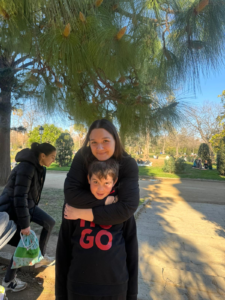Teaching as a Language Assistant in any Spanish school necessarily requires a significant portion of your time to be spent there, so it is of vital importance for you and those around you that you feel comfortable and happy within the school environment. A big part of successfully immersing yourself in Spanish culture lies in the context of your school: both in getting on with the rest of the staff, and in adapting yourself to classrooms in schools in Spain.
Some Things You Need to Know About Schools in Spain
What are Schools in Spain Like?
Before you start teaching, many people will warn you that schools of Spain are very different from those in the US, the UK, and other parts of Europe. They will say that Spanish classrooms blaze with loudness, disorder, and unconstraint.
While it is generally true that Spanish people are expressive and open, I think students bring similar disruptions to classes around the world. I teach teenagers, and while it would be easy to dismiss cases of bad behavior as ingrained cultural difference, I’m pretty sure most of the challenges I meet with every day are the same ones my teachers faced back in the UK.

My Tips to Fit in Schools in Spain
Having said this, here are a few tips base on my experience in Colegio Sagrado Corazón de Jesús, in Cáceres, on how to gain the respect of students and get on well with members of staff:
1. Say Hello to Everyone you Walk Past
Once you start at a Spanish school, you’ll soon realize that this is simply what’s done. Smiling at and responding to staff and students will show them you’re polite, engaged, and happy to be there.

2. Say Yes
You’ve probably received this piece of advice countless times. That’s because it’s stellar advice. I’m now going on regular 25km hikes because a teacher at my school invited me along with her hiking club. I get to visit beautiful terrains I would never be able to independently navigate, giving myself a very healthy dose of exercise, fresh air, and Spanish practice with a lovely group of people in the process.
3. Project and Use Your Body
If you’ve ever watched an insecure friend or student trying to present in front of a class, you’ll understand that confidently doing something silly is far less embarrassing than unconfidently doing something sensible. I get lots of laughs (and students on my side) by miming, putting on different voices and such.
4. Remember that Your Colleagues Will Have Different Teaching Styles
Different schools make use of Language Assistants in different ways, so you may find that your role entails conducting conversations with one or two students at a time, or teaching small groups on your own. Either way, if you’re put in front of a whole classroom, there will always* be another teacher with you.
*in the graduate and speakers program
If like me, you find yourself with four different teachers over the course of a week, you must remember that teachers, just like everyone else in life, are individuals. There is no one style of teaching that fits all; you must learn to adapt to the people you work with.
5. Be Proactive when Teaching in Schools in Spain
It’s true to say that Spanish culture is more laid back as far as planning and communication goes. Try to relax as much as possible, but also remember that you can keep asking (or WhatsApping) anyone who you think may hold the information you’re after. Indeed, they will more than likely be very happy to help you if they can. Don’t be afraid to badger people!

6. Have Fun with Your Lesson Plans
There’s nothing worse than going in to teach a group of grumpy, unmotivated teenagers a lesson which you yourself aren’t even digging. As a Language Assistant, all the lessons you give can be packed with engaging activities; like games which require students to move around the room; or watching music videos once you have found out what genres of music your students favor.
7. Don’t Push against the Students, Work with Them
All classes have different rhythms. If one group is generally quieter and less confident while another is louder and more easily distracted, don’t despair. Maybe no one in the first group ever answers your questions, while no one in the second group ever listens to you. Instead of despairing, think about the preferred learning methods of each group and design your lessons accordingly.
8. Adapt to the Mood and Volume of a Class
Equally, if a whole class seems more restless, more subdued, or more anything than usual, there’s usually a reason behind this. There are always ways to tailor a lesson last-minute to suit the needs of your class.
9. Learn Names
It’s hard to learn everyone’s names when you are teaching hundreds of students, but it makes a huge difference. (It’s also easier to accomplish than you think because if they’re a boy there’s a 50% chance they are called Juan, Javier or Pablo, while girls are very often Maria, Laura or Isabel!)
10. Positive Reinforcement, positive Reinforcement, positive Reinforcement
This is always so much more encouraging, attractive, and, well, positive, to use as a method of disciplining if possible.

11. Stay Positive. Stay Adult
Teaching is hard but very rewarding. Often if a student is acting up it will be because they don’t understand or feel like they can’t do what you’ve asked of them. Always remember this and be sympathetic to it.
12. Never Give Up Your Water Habit
Just because you will never spot Spanish teachers or students with a bottle of water in their hands, doesn’t mean you should sacrifice your own hydration levels. You do you.












19 Responses
I definitely agree with all of the points you’ve made! Saying hello to my students whenever I see them in the hallway has led to them going out of their way to run me down when I’m walking in the street to say hello. It is impossible for me to walk through the main square of the city I’m living in without hearing several different students calling out my name which is SUCH a great feeling. I also agree with what you said about the mood of the classroom. I see my students once every two weeks for a conversation class, so it took me quite a while to feel out the tone of each of my different classes. Tailoring different activities to different groups depending on their different interests has made a huge difference on overall engagement in my class! Positive reinforcement is also a huge part of what I do. Highlighting the kids that are doing their work and rewarding them is a great way to keep the good students motivated and the less-focused students on task.
I think all these tips are so helpful! I definitely agree with making sure to have fun in lessons. Students LOVE our lessons because they are so different from the usual math and science classes that they take. As language assistants, we get the chance to make our lessons as creative and fun as we want! We have the freedom to make it as interactive and entertaining as possible. While some students are absolute angels, of course, you’ll have some students who won’t listen to anything you say. Working with the students and not against them is extremely crucial especially since you don’t know their outside circumstances. Creating a positive learning environment is really important as this supports their learning and engagement in the classroom.
This is such a helpful post! I’ve been placed in a small, very touristic area and it can be hard to feel included sometimes. What I’ve found to be really helpful is asking a lot of questions of the teachers and the students and being really open minded. Not only is this a benefit to me, because I learn so much about the local area/customs/people, but it means they open up to me and has meant I’ve made some really great friends 😀
I think one of the greatest challenges I had at the beginning was adapting to my different colleagues. I work with five different teachers throughout my week and with time I am now starting to get into the groove with my colleagues and we have learned each other’s weaknesses and strengths and are able to assist each other in the classroom. This rhythm took time to establish though, so I would also point out that it’s okay to not have the best flow right away, but to not give up! Some teachers’ styles will fit perfectly with yours and others you may have to reflect or think about more. I enjoy working with different teachers to learn new skills for classroom management and teaching techniques. I think it’s also important to keep in mind that everything in education is a learning process and changes constantly, so embrace it!
This is such a great blog post Phoebe. I quickly learned last year that simply saying ‘hello’ to every teacher (even the ones you have never seen before, because some Spanish schools are like small countries!) makes people warm up to you so much. And more than this, it cheers you up and makes you feel part of the school more!
I also really love your point about asking for help! Last year, I always felt apprehensive about asking people for what I needed as I didn’t want to seem like I didn’t know what I was doing, but I have started to this year and it has made it so much easier.
It sounds like you’re having a great experience, thank you for the tips and advice!
Ps. LOVE THE WATER BOTTLE COMMENT. So many teachers make fun of me for ALWAYS having my bottle with me hahaha!
Wow I relate so much to the water bottle point. I go downstairs to the cafeteria every day to fill it up! Otherwise, I love your points about adapting to the culture in the Spanish classrooms and across the teaching styles. I find it super interesting at my school where there are many English teachers from other countries as well. You can see how they all approach a classroom differently and it gives a huge perspective on different cultures and what works where. I’m itching to sit in on a classroom with a Spanish teacher to observe how he/she manages the kids when they get rowdy.
Totally agree with “always smile and say hello” to everyone you walk past. I feel like even in my school when someone leaves a room it can be rude not to say “Adeu!” (catalan goodbye :))
These tips are so true. I have found that everyone says hello to everyone here, even if you cant remember names! In a school of 100+ teachers I have found it so difficult to learn everyone’s names here, including the students. I wish I had tried to remember them more at the start of the year because now its too late to ask them again! One thing I would add is to try and learn some basic conversational Spanish so you can talk to teachers in the school who may not know English. I have found this helpful in communicating with teachers every day.
Yes to all of these! Especially the positive reinforcement, I wasn’t using it as much in the beginning and now I have noticed what a huge difference it makes in the classroom!
Thanks for the tips!
HELLO! HOW ARE YOU? All day, every day haha
Absolutely. The different styles of teaching and lesson expectations threw me a bit at first but now I’ve got used to it I think it’s been a vary positive aspect of the experience. I’ve learnt so much more from observing so many different teaching styles.
Your points are so true! I probably say “hello” or “hola” 100 times a day and I don’t only try to communicate with the people I work with or my students but also other teachers and staff in the school. It is always important to say “yes” to things as it shows you are interested, even if that’s simply grabbing a coffee after lunch (something I’ve done many times). People really appreciate it when they see you making the effort and it works both ways. You are SO right about teachers having different styles and expectations of you in the class. I teach in a variety of ways too and each teacher is different but that’s something you get used to after time and it actually makes it diverse. I feel like I’m learning a lot from the different teachers and their methods. And while it’s so hard to learn hundreds of names, it’s important to try and remember (I’m still learning names every week!)
Absolutely. The different styles of teaching and lesson expectations threw me a bit at first but now I’ve got used to it I think it’s been a vary positive aspect of the experience. I’ve learnt so much more from observing so many different teaching styles.
I completely agree about being proactive! It’s very important to show your teachers you are willing to do a little extra. Trust me, they want it and will love you for it! Sometimes teachers just forget to ask you to do things, so it’s definitely a good idea to ask them instead of them asking you! Being positive and flexible is also very important! Just relax and try not to stress too much, because this could be a way to ruin or lessen your experience!
Thanks Phoebe for your great blog post, I found it really informative and the tips are great because they apply not only to newcomers, but also to those of us working already who might find it hard sometimes to socialise at school. One other tip I would add is not to be intimidated by the Spanish language. Many assistants believe they are only meant to speak English at all times at school which is ideal in theory, but near impossible in reality as not all the teachers speak English! (At least in my school, the majority don’t speak English). Instead of seeing it as a hindrance to socialising, we can try and use it to our advantage to practise Spanish and gain some rapport in the staff room. What do you think?
Thanks again for all the advice!! Never been to Cáceres, but it looks lovely 🙂
Hannah
Yes completely agreed! Pretty much only the English teachers in my school can speak English, which I love, because it means when I go for coffee with the staff every break-time I absolutely have no other option than to speak Spanish. They’re all very encouraging with it too and make an effort to speak slowly when talking to me.